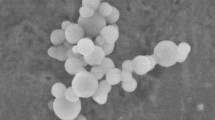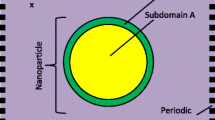Abstract
A modelling of the thermal conductivity of nanofluids based on extended irreversible thermodynamics is proposed with emphasis on the role of several coupled heat transfer mechanisms: liquid interfacial layering between nanoparticles and base fluid, particles agglomeration and Brownian motion. The relative importance of each specific mechanism on the enhancement of the effective thermal conductivity is examined. It is shown that the size of the nanoparticles and the liquid boundary layer around the particles play a determining role. For nanoparticles close to molecular range, the Brownian effect is important. At nanoparticles of the order of 1–100 nm, both agglomeration and liquid layering are influent. Agglomeration becomes the most important mechanism at nanoparticle sizes of the order of 100 nm and higher. The theoretical considerations are illustrated by three case studies: suspensions of alumina rigid spherical nanoparticles in water, ethylene glycol and a 50/50w% water/ethylene glycol mixture, respectively, good agreement with experimental data is observed.
Similar content being viewed by others
References
Marín E., Bedoya A., Alvarado S., Calderón A., Ivanov R., Gordillo-Delgado F.: An explanation for anomalous thermal conductivity behaviour in nanofluids as measured using the hot-wire technique. J. Phys. D: Appl. Phys. 47, 085501 (2014)
Keblinski P., Phillpot S.R., Choi S.U.S., Eastman J.A.: Mechanisms of heat flow in suspensions of nano-sized particles (nanofluids). Int. J. Heat Mass Transf. 45, 855–863 (2002)
Keblinski P., Eastman J.A., Cahill D.G.: Nanofluids for thermal transport. Mater. Today 8, 36–44 (2005)
Wang X.-Q., Mujumdar A.S.: A review of nanofluids—Part I: theoretical and numerical investigations. Braz. J. Chem. Eng. 25, 613–630 (2008)
Iranidokht V., Hamian S., Mohammadi N., Shafii M.B.: Thermal conductivity of mixed nanofluids under controlled pH conditions. Int. J. Thermal Sci. 74, 63–71 (2013)
Bruggeman D.A.G.: Berechnung verschiedener physikalischer Konstanten von heterogenen Substanzen. Annal. Phys. 24, 636–679 (1935)
Maxwell J.C.: Treatise on Electricity and Magnetism. Clarendon, Oxford (1881)
Nan C.-W., Birringer R., Clarke D.R., Gleiter H.: Effective thermal conductivity of particulate composites with interfacial thermal resistance. J. Appl. Phys. 81, 6692 (1997)
Lebon G., Machrafi H.: Thermal conductivity of tubular nanowire composites based on a thermodynamic model. Phys. E 71, 117–123 (2015)
Ordonez-Miranda J., Yang R., Alvarado-Gil J.J.: On the thermal conductivity of particulate nanocomposites. Appl. Phys. Lett. 98, 233111 (2011)
Behrang A., Grmela M., Dubois C., Turenne S., Lafleur P.G.: Influence of particle-matrix interface, temperature and agglomeration on heat conduction in dispersions. J. Appl. Phys. 114, 014305 (2013)
Lebon G., Machrafi H., Grmela M.: An extended irreversible thermodynamic modelling of size-dependent thermal conductivity of spherical nanoparticles dispersed in homogeneous media. Proc. R. Soc. A 471, 20150144 (2015)
Xie H., Fujii M., Zhang X.: Effect of interfacial nanolayer on the effective thermal conductivity of nanoparticle-fluid mixture. Int. J. Heat Mass Transf. 48, 2926–2932 (2005)
Yu W., Choi S.U.S.: The role of interfacial layers in the enhanced thermal conductivity of nanofluids: A renovated Maxwell model. J. Nanopart. Res. 5, 167–171 (2003)
Pasrija R., Srivastava S.: The interfacial layer effect on thermal conductivity of nano-colloidal dispersions. Int. J. Appl. Phys. Math. 4, 1–4 (2014)
Kole M., Dey T.K.: Role of interfacial layer and clustering on the effective thermal conductivity of CuO–gear oil nanofluids. Exp. Thermal Fluid Sci. 35, 1490–1495 (2011)
Chen H., Ding Y., Tan C.: Rheological behaviour of nanofluids. New J. of Phys. 9, 367–390 (2007)
Kochetov R., Korobko A.V., Andritsch T., Morshuis P.H.F., Picken S.J., Smit J.J.: Modelling of the thermal conductivity in polymer nanocomposites and the impact of the interface between filler and matrix. J. Phys. D: Appl. Phys. 44, 395401 (2011)
Timofeeva E.V., Gavrilov A.N., McCloskey J.M., Tolmachev Y.V.: Thermal conductivity and particle agglomeration in alumina nano-fluids: experiment and theory. Phys. Rev. E 76, 061203 (2007)
Anoop K.B., Kabelac S., Sundararajan T., Das S.K.: Rheological and flow characteristics of nanofluids: Influence of electroviscous effects and particle agglomeration. J. Appl. Phys. 106, 034909 (2009)
Xiao B., Yang Y., Chen L.: Developing a novel form of thermal conductivity of nanofluids with Brownian motion effect by means of fractal geometry. Powder Technol. 239, 409–414 (2013)
Azizian R., Doroodchi E., Moghtaderi B.: Effect of nanoconvection caused by Brownian motion on the enhancement of thermal conductivity in nanofluids. Ind. Eng. Chem. Res. 51, 1782–1789 (2012)
Jang S.P., Choi S.U.S.: Role of Brownian motion in the enhanced thermal of nanofluids. Appl. Phys. Lett. 84, 4316–4318 (2004)
Reissland J.A.: The Physics of Phonons. Wiley, London (1973)
Michaelides E.E.: Transport properties of nanofluids. A critical review. J. Non-Equilib. Thermodyn. 38, 1–79 (2013)
Thang B.H., Khoi P.H., Minh P.N.: A modified model for thermal conductivity of carbon nanotube-nanofluids. Phys. Fluids 27, 032002 (2015)
Mizzi S., Barber R.W., Emerson D.R., Reese J.M., Stefanov S.K.: A phenomenological and extended continuum approach for modelling non-equilibrium flows. Contin. Mech. Thermodyn. 19, 273–283 (2007)
Sisman A., Babac G.: Quantum size effects on classical thermosize effects. Contin. Mech. Thermodyn. 24, 339–346 (2012)
Alber, H.D., Hutter, K., Tsakmakis, Ch.: Nonconventional thermodynamics, indeterminate couple stress elasticity and heat conduction, Contin. Mech. Thermodyn. (2014). doi:10.1007/s00161-014-0406-1
Jou D., Casas-Vàzquez J., Lebon G.: Extended Irreversible Thermodynamics. 4th edition. Springer, New York (2010)
Lebon G., Jou D.: Early history of extended irreversible thermodynamics (1953–1983): An exploration beyond local equilibrium and classical transport theory. Eur. Phys. J. H 40, 205–240 (2014)
Jou D., Casas-Vazquez J., Lebon G.: Extended irreversible thermodynamics, a brief introduction. Proc. Estonian Acad. Sci. 57, 118–128 (2008)
Cimmelli V.A., Jou D., Ruggeri T., Van P.: Entropy principle and recent results in non-equilibrium theories. Entropy 16, 1756–1807 (2014)
Machrafi H., Lebon G.: Effective thermal conductivity of spherical particulate nanocomposites: Comparison with theoretical models, Monte Carlo simulations and experiments. Int. J. Nanosci. 13, 1450022 (2014)
Das S.K., Nandy P., Thiesen P., Roetzel W.: Temperature dependence of thermal conductivity enhancement for nanofluids. J. Heat Transf. 125, 567–575 (2003)
Hondaraju S., Jin E.K., Lee S.J.: Direct simulation of thermal conductivity of nanofluids; The effect of temperature two-way coupling and coagulation of particles. Int. J. Heat Mass Transf. 53, 962 (2010)
Prasher R., Bhattacharya P., Phelan P.E.: Brownian-motion-based convective-conductive model for the effective thermal conductivity of nanofluids. J. Heat Transf. 128, 588–595 (2006)
Jang S.P., Choi S.U.S.: Effects of various parameters on nanofluid thermal conductivity. J. Heat Transf. 129, 617–623 (2007)
de Groot S.R., Mazur P.: Non-Equilibrium Thermodynamics. North-Holland Publishing Company, Amsterdam (1962)
Spencer A.J.M, Rivlin R.S.: Further results in the theory of matrix polynomials. Arch. Ration. Mech. Anal. 4, 214 (1959)
Jou D., Casas-Vazquez J., Lebon G., Grmela M.: A phenomenological scaling approach for heat tranfer in nano-systems. Appl. Math. Lett. 18, 963–967 (2005)
Dreyer W., Struchtrup H.: Heat pulse experiments revisited. Contin. Mech. Therm. 5, 3–50 (1993)
Hess S.: On nonlocal constitutive relations, continued fraction expansion for the wave vector dependent diffusion coefficient. Z. Naturforsch. 32, 678–684 (1977)
Hashimoto T., Fujimura M., Kawai H.: Domain-boundary structure of styrene-isoprene block co-polymer films cast from solutions. Macromolecules 13, 660–669 (1980)
Li Z.H., Gong Y.J., Pu M., Wu D., Sun Y.H., Wang J., Liu Y., Dong B.Z.: Determination of interfacial layer thickness of a pseudo two-phase system by extension of the Debye equation. J. Phys. D: Appl. Phys. 34, 2085–2088 (2001)
Yu C.J., Richter A.G., Datta A., Durbin M.K., Dutta P.: Molecular layering in a liquid on a solid substrate: an X-ray reflectivity study. Phys. B 283, 27–31 (2000)
Xue L., Keblinski P., Phillpot S.R., Choi S.U.S., Eastman J.A.: Effect of liquid layering at the liquid-solid interface on thermal transport. Int. J. Heat Mass Transf. 47, 4277–4284 (2004)
Murshed S.M.S., Leong K.C., Yang C.: A combined model for the effective thermal conductivity of nanofluids. Appl. Therm. Eng. 29, 2477–2483 (2009)
Barnes H.A., Hutton J.F., Walters K.: An Introduction to Rheology. Elsevier, Amsterdam (1989)
Goodwin J.W., Hughes R.W.: Rheology for Chemists—An Introduction. The Royal Society of Chemistry, Cambridge (2000)
Wang B.X., Zhou L.P., Peng X.F.: A fractal model for predicting the effective thermal conductivity of liquid with suspension of nanoparticles. Int. J. Heat Mass Transf. 46, 2665–2672 (2003)
Prasher R., Evans W., Meakin P., Fish J., Phelan P., Keblinski P.: Effect of aggregation on thermal conduction in colloidal nanofluids. Appl. Phys. Lett. 89, 143119 (2006)
Hui P.M., Zhang X., Markworth A.J., Stroud D.: Thermal conductivity of graded composites: numerical simulations and an effective medium approximation. J. Mater. Sci. 34, 5497–5503 (1999)
Prasher R., Bhattacharya P., Phelan P.E.: Thermal conductivity of nanoscale colloidal solutions (nanofluids). Phys. Rev. Lett. 94, 025901 (2005)
Kaviany M.: Essentials of Heat Transfer. Cambridge University Press, Cambridge (2011)
Jamal-Abadi M.T., Zamzamian A.H.: Optimization of thermal conductivity of Al2O3 nanofluid by using ANN and GRG methods. Int. J. Nanosci. Nanotechnol. 9, 177–184 (2013)
Xie H., Wang J., Xi T., Liu Y., Ai F., Wu Q.: Thermal conductivity enhancement of suspensions containing nanosized alumina particles. J. Appl. Phys. 91, 4568 (2002)
Witharana, S., Weliwata, J.A.: Suspended nanoparticles as a way to improve thermal energy transfer efficiency. ICIAFS Conf. (2012). doi:10.1109/ICIAFS.2012.6419922
Beck M.P., Yuan Y., Warrier P., Teja A.S.: The effect of particle size on the thermal conductivity of alumina nanofluids. J. Nanopart. Res. 11, 1129–1136 (2009)
Li C.H., Peterson G.P.: The effect of particle size on the effective thermal conductivity. J. Appl. Phys. 101, 044312 (2007)
Lee S., Choi S.U.S., Li S., Eastman J.A.: Measuring thermal conductivity of fluids containing oxide nanoparticles. J. Heat Transf. 121, 280–289 (1999)
Beck M.P., Yuan Y., Warrier P., Teja A.S.: The thermal conductivity of alumina nanofluids in water, ethylene glycol, and ethylene glycol + water mixtures. J. Nanopart. Res. 12, 1469–1477 (2010)
Wang X.W., Xu X.F., Choi S.U.S.: Thermal conductivity of nanoparticle-fluid. J. Thermophys. Heat Transf. 13, 474–480 (1999)
Koo J., Kleinstreuer C.: A new thermal conductivity model for nanofluids. J. Nanopart. Res. 6, 577–588 (2004)
Gupta A., Kumar R.: Role of Brownian motion on the thermal conductivity enhancement of nanofluids. Appl. Phys. Lett. 91, 223102 (2007)
Das S.K., Choi S.U.S., Yu W., Pradeep T.: Nanofluids: Science and Technology. Wiley, New Jersey (2008)
Nie C., Marlow W., Hassan Y.A.: Discussion of proposed mechanism of thermal conductivity enhancement in nanofluids. Int. J. Heat Mass Transf. 51, 1342–1348 (2008)
Shima P.D., Philip J., Raj B.: Role of microconvection induced by Brownian motion of nanoparticles in the enhanced thermal conductivity of stable nanofluids. Appl. Phys. Lett. 94, 223101 (2009)
Kleinstreuer C., Feng Y.: Experimental and theoretical studies of nanofluid thermal conductivity enhancement: a review. Nanoscale Lett. 6, 229 (2011)
Evans W., Fish J., Keblinski P.: Role of Brownian motion hydrodynamics on nanofluid thermal conductivity. Appl. Phys. Lett. 88, 093116 (2006)
Fang K.C., Weng C.I., Ju S.P.: An investigation into the structural features and thermal conductivity of silicon nanoparticles using molecular dynamics simulations. Nanotechnology 17, 3909–3914 (2006)
Sridhara V., Satapathy L.N.: Al2O3-based nanofluids: a review. Nanoscale Lett. 6, 456 (2011)
Author information
Authors and Affiliations
Corresponding author
Additional information
Communicated by Andreas Öchsner.
Rights and permissions
About this article
Cite this article
Machrafi, H., Lebon, G. The role of several heat transfer mechanisms on the enhancement of thermal conductivity in nanofluids. Continuum Mech. Thermodyn. 28, 1461–1475 (2016). https://doi.org/10.1007/s00161-015-0488-4
Received:
Accepted:
Published:
Issue Date:
DOI: https://doi.org/10.1007/s00161-015-0488-4




